Mistakes on Ordering & Fogstar’s Support Tested.
On ordering, I managed to do the one thing every engineer dreads – I clicked the wrong button. Instead of the 16.1 kWh unit I actually wanted, I somehow ordered the 15.2 kWh version. It was Friday, 4 p.m. on the dot. I hit confirm order, felt that fleeting moment of satisfaction and then realised my mistake exactly two seconds after the Fogstar site proudly declared, “Thank you for your purchase.”
Cue immediate panic. The office had just closed for the weekend. No phone support. No live chat. Just me, sweating, staring at the screen as my wife stood behind me with that look — the one that silently says, “what have you done this time?” The universal expression of someone watching a man try to undo his own disaster in real time. There I was, frantically clicking through every support page like a caffeine-addled raccoon trying to hack its way back into a closed checkout system.
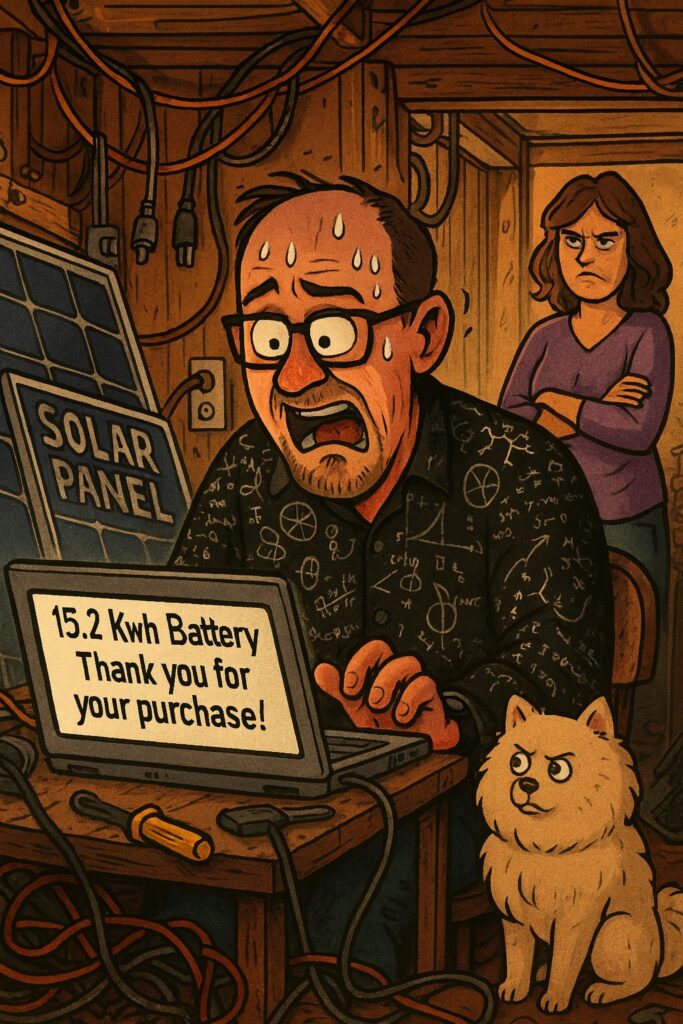
Most companies would have left me to stew in that anxiety until Monday, by which point I’d be neck-deep in refund requests and automated apologies. But to Fogstar’s credit, they didn’t. Come Monday morning, at precisely 09:15, I phoned them. The moment I handed over my order number, the gentleman on the other end chuckled and said, “We wondered why you ordered that battery – no one’s bought that model in six months. I’ll correct it straight away. Anything else I can help with?”.
No penalty. No delay. No smug “you should have double-checked your cart” lecture. Just quiet, competent service. That short exchange told me everything I needed to know about Fogstar’s DNA. They don’t hide behind policy or ticketing systems. They fix things – quickly and without drama.
Once the correction was made, the rest of the process unfolded exactly as a professional operation should. That same afternoon, I received a second email confirming the amendment and outlining a refreshingly detailed set of delivery options.
Fogstar didn’t just dump a vague “your item will be shipped soon” message into my inbox they offered actual choice. The email clearly listed several delivery options: smaller van access for tighter roads, weekend delivery for those who work weekdays, and a few other payable extras for those wanting more flexibility. It was the kind of communication that assumes the customer can think, rather than forcing them into one-size-fits-all logistics.
I opted for the simplest route: standard kerbside delivery, free of charge, within two days. The documentation was clear and honest roadside delivery meant exactly that. It was the driver’s discretion whether he’d bring it any closer to the property, depending on access and safety. No hidden clauses, no misleading promises, just transparent, professional terms.
And I respected that. I was perfectly fine with an articulated lorry blocking the street for a few minutes while 140 kilograms of lithium-based responsibility was carefully unloaded onto my driveway. Clarity and honesty in delivery expectations go a long way and Fogstar nailed that part perfectly.
The Delivery
That morning, the artic lorry arrived like a mechanical colossus, casting a shadow so vast it seemed to blot out the sun itself. The roar of its brakes echoed down the street as it came to a halt, blocking not just my drive but most of the daylight from my windows. My quiet street had suddenly become the set of War of the Worlds: The Battery Edition.
The driver climbed down from his cab, clipboard in hand, the sort of man who looked entirely unfazed by parking forty tonnes of steel outside someone’s house. I scrambled for my trainers, half awake, half in awe, and hurried outside to meet him. He gave a polite nod and asked where I’d like the pallet placed. I pointed toward the bottom of the drive, hoping I wasn’t about to test the limits of his patience or his pallet truck.
“Yeh, not an issue,” he said, calm as a surgeon.
Then, with all the finesse of a practiced pro, he climbed onto the back of the artic, rolled out a heavy-duty pallet lifter, and began manoeuvring what looked like a small wooden bunker my Fogstar 16.1 kWh battery toward the edge. He lowered it down with surgical precision, trundled it around to the front of the house, and positioned it perfectly.
Then, to my surprise, he asked, “Do you need a hand unboxing it?”
For a moment, I nearly said yes because who wouldn’t want backup for a 140 kg slab of lithium? But pride won out. I grinned and replied, “No, it’s alright mate, thank you for your help.”
He smiled, climbed back into the cab, and within minutes, the great machine rumbled away, unlocking the street and restoring sunlight to my home. The neighbours emerged from their curtains. The lorry’s shadow faded. And there I stood, one man, one shed, and one colossal battery now sitting proudly on my drive, ready to power the chaos once more.
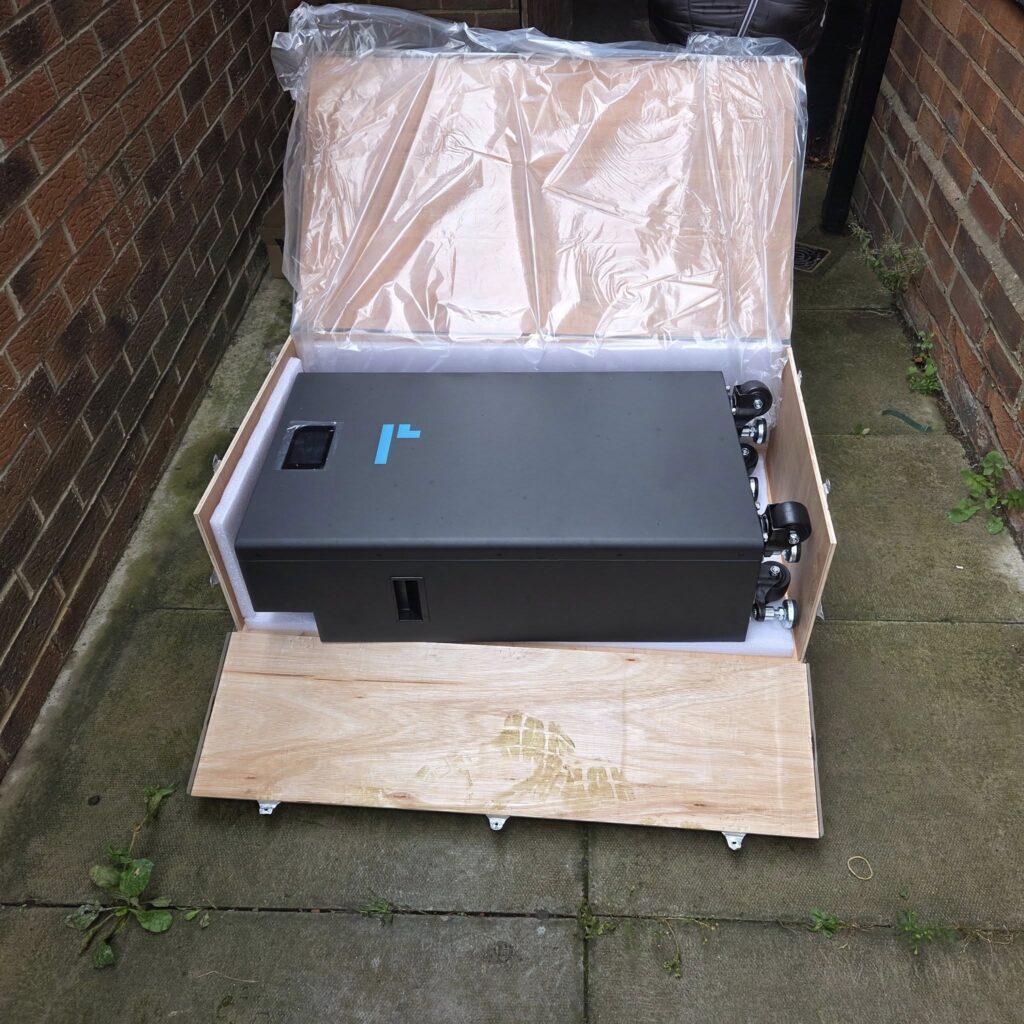
Unboxing the Beast
I stood before the crate hammer in one hand, flathead screwdriver in the other ready for battle. The molotov-grade wooden box that had journeyed across the country sat in defiance, daring me to free its contents. With a few firm taps and the occasional persuasive whack, the panels gave way, and the lid creaked open like the gates of Valhalla.
Inside, nestled in foam and reinforced padding, was my prize: a pristine Fogstar 16.1 kWh battery, gleaming under the morning light like a relic forged by engineers rather than gods. For a moment, I just stood there, admiring it. The smile on my face could’ve powered a solar inverter all by itself.
Then came the next step standing it upright. Emphasis on tried.
One hundred and forty kilograms of precision-engineered lithium doesn’t exactly leap to attention. I squatted, braced, and began to lift. My back immediately filed a formal protest, my arms went on strike, and a small voice in my head whispered, “This is how legends die.”
I paused for a second, growled like an angry caveman defying evolution itself, and gave it everything I had. The battery slowly tilted, then rolled onto its wheels with a thud that made my spine question my life choices.
Behind me, my wife ever the voice of reason asked through laughter, “Do you want some help?”
I ignored her completely, too deep in my moment of triumph. Unfortunately, nature had its own comedic timing. In the middle of the heave, I let out an unplanned, trumpet-like fanfare. My wife collapsed into uncontrollable laughter, tears in her eyes, barely able to breathe.
And there I was red-faced, victorious, standing beside my newly freed Fogstar like some deranged strongman, proud, broken, and slightly lighter than before.

Moving the Monolith to the Shed of Chaos
Next came the part I had conveniently erased from memory the journey to the Shed of Chaos.
The shed sits proudly at the far end of the garden, roughly twenty metres beyond the old coal house. Between it and civilisation lies an expanse of wet, uneven grass pretending to be a lawn. No paving. No grip. Just mud, puddles, and despair.
The first challenge was simple in theory: getting the 140 kg Fogstar 16.1 kWh unit up a single small step. You’d think one step wouldn’t matter. It did. My spine still sends complaints. After a mix of tactical swearing, grunting, and precision leverage, I managed to shuffle it through the coal house and into open air where the true problem revealed itself.
There I stood, staring down twenty metres of soaked grass, rain still glistening on the blades, and muttered the sacred words of doomed engineers everywhere: “Right… how are we going to get this down there?”
Inspiration or lunacy struck. I sprinted back to the now-empty wooden crate and tore it apart like a rabid archaeologist. Out came every sheet of plywood I could salvage. I returned to the garden, arms full, face beaming with the kind of confidence only an idiot enjoys.
“Do you know how the Egyptians moved stones?” I asked, with the smug pride of a man about to embarrass himself.
My wife raised an eyebrow. “Nope. What are you talking about, you loony?”
“This!” I declared, brandishing a sheet of plywood like the Rosetta Stone. “You lay one in front of the other while I roll it forward. No gaps. Keep it tight. This is science.”
It worked initially. The first sheet held. The second rolled smooth. The third, elegant. By the fourth, I was beginning to believe my own genius. Then came the slope. Gravity, patient until now, decided to intervene. The fifth board shifted, leaving a gap perfectly sized to trap both front casters.
The Fogstar dipped, lunged, and suddenly I was clinging to it like a rodeo clown. Mud flew. I shouted something unprintable in ancient Egyptian. My wife, bent double laughing, tried to grab another board while I yelled, “Quick! Under it!”
She slid it in just as I wrenched the beast back upright, saving it from a muddy grave. We paused. I stood panting, filthy, and half-victorious. My wife couldn’t breathe for laughing. I couldn’t feel my legs.
And yet, against all logic, we carried on. Sixth sheet. Seventh. Eighth. A muddy relay of stubbornness and bad physics until finally we reached the Shed of Chaos.
Then came the final insult: the shed floor sat half a foot higher than the grass. I just stared at it. For a long, silent moment, I genuinely considered crying.
Instead, we pushed together the battered plywood, scrounged up a few 2×4s from the garden, and built a crude ramp. My wife offered to help push. I laughed. I knew her heart was in it, but unless she’d secretly joined the World’s Strongest Woman competition, there was no chance.
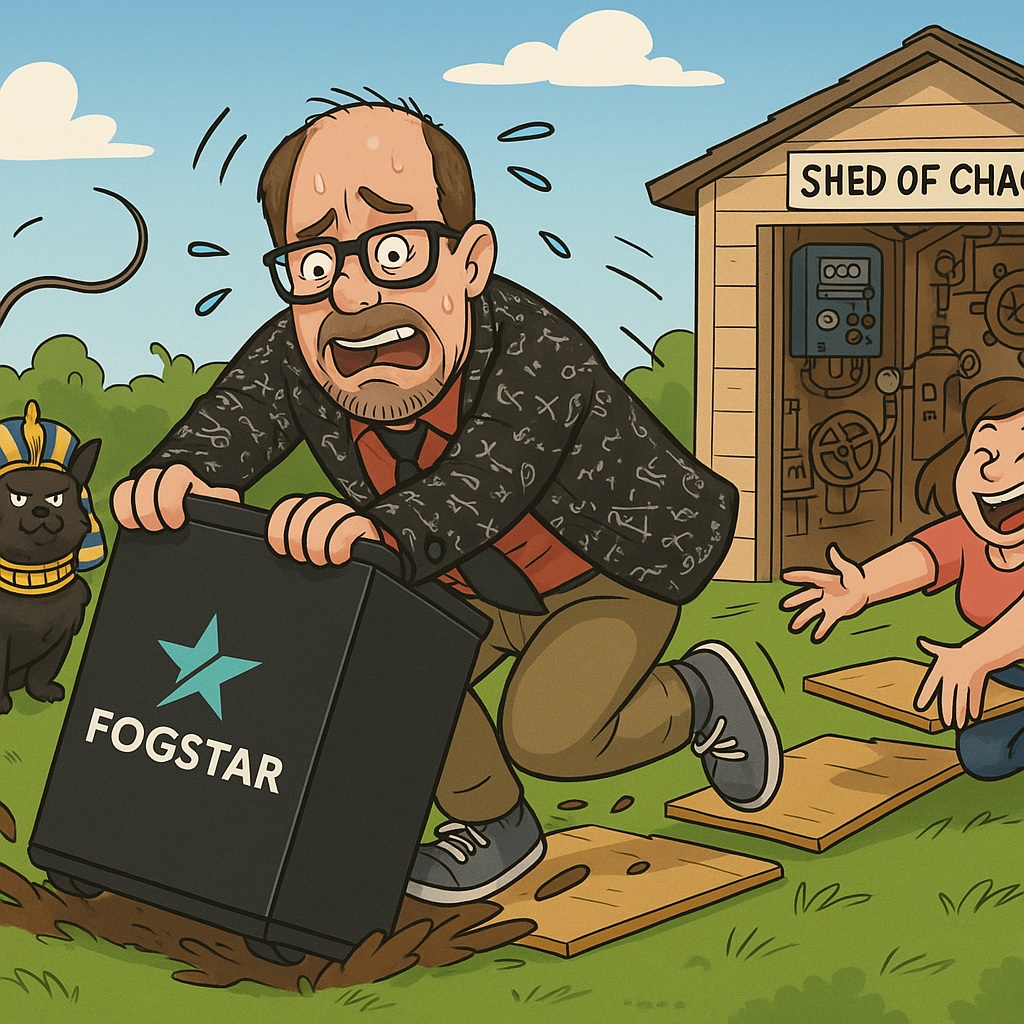
So I braced myself, gripped the frame, and unleashed a primal “ARRRRRRR!” worthy of a Viking. Against all reason, the Fogstar rolled up the ramp like it was weightless and slid neatly into place inside the shed.
I dropped to my knees, soaked in sweat and triumph, whispering, “Never again.”
Of course, I knew I was lying. Because if this battery worked the way I hoped… I’d be doing it all again soon.
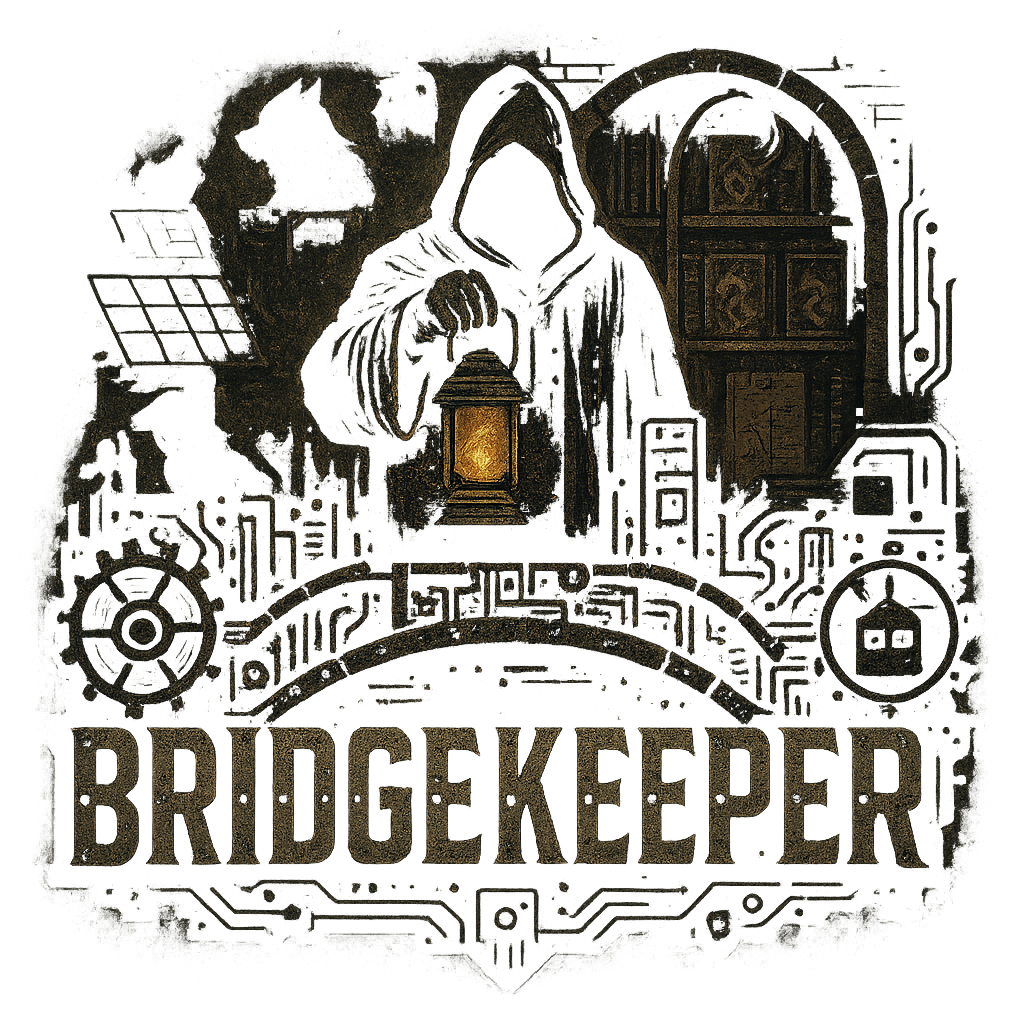
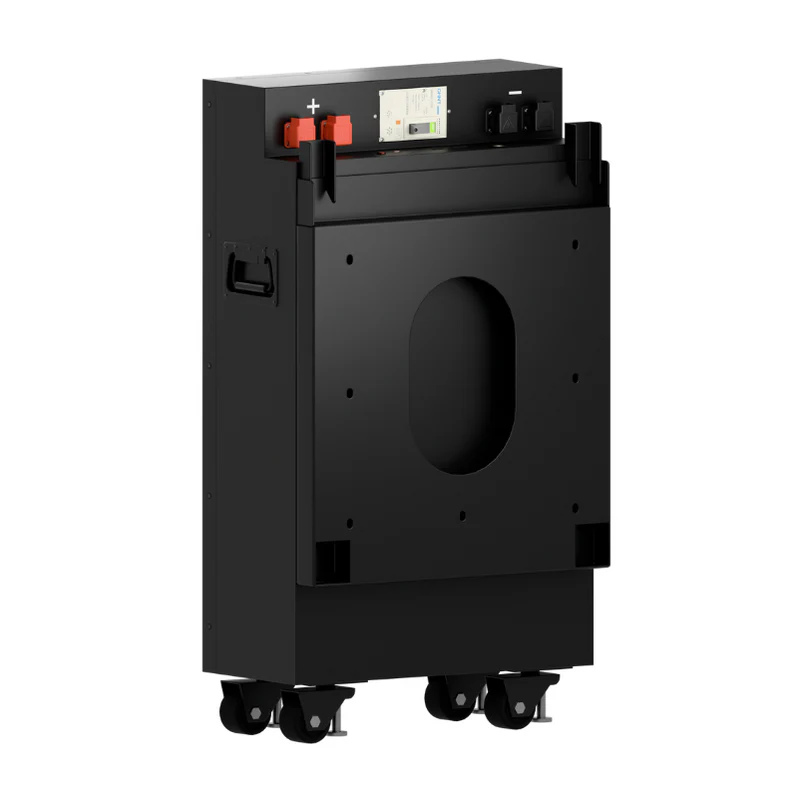
Leave a Reply